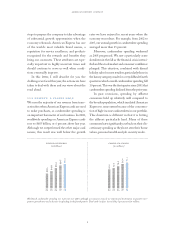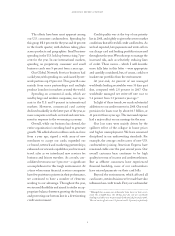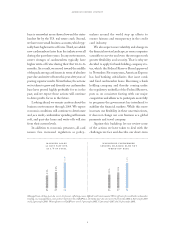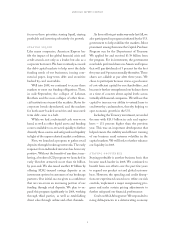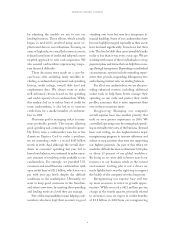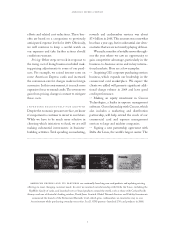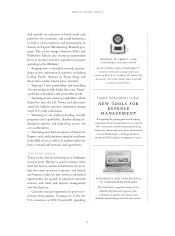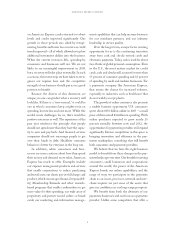American Express 2008 Annual Report Download - page 14
Download and view the complete annual report
Please find page 14 of the 2008 American Express annual report below. You can navigate through the pages in the report by either clicking on the pages listed below, or by using the keyword search tool below to find specific information within the annual report.2008 financial review
american express company
financial review
The financial section of American Express Company’s (the
Company) Annual Report consists of this Financial Review,
the Consolidated Financial Statements and the Notes to the
Consolidated Financial Statements. The following discussion
is designed to provide perspective and understanding to the
Company’s consolidated financial condition and results of
operations. Certain key terms are defined in the Glossary of
Selected Terminology, which begins on page 57.
This Financial Review and the Notes to the Consolidated
Financial Statements have been adjusted to exclude discontinued
operations unless otherwise noted.
executive overview
American Express Company, a bank holding company, is a
leading global payments and travel company. The Company’s
principal products and services are charge and credit payment
card products and travel-related services offered to consumers
and businesses around the world. The Company’s businesses
are organized into two customer-focused groups, the Global
Consumer Group and the Global Business-to-Business Group.
The Global Consumer Group offers a range of products and
services including charge and credit card products for consumers
and small businesses worldwide primarily through its U.S.
bank subsidiaries and affiliates; consumer travel services; and
stored value products such as Travelers Cheques and prepaid
products. The Global Business-to-Business Group offers
business travel, corporate cards and other expense management
products and services; network services for the Company’s
network partners; and merchant acquisition and merchant
processing, point-of-sale, servicing and settlement and
marketing products and services for merchants. The Company’s
various products and services are sold globally to diverse
customer groups, including consumers, small businesses,
middle-market companies, and large corporations. These
products and services are sold through various channels
including direct mail, on-line applications, targeted sales
forces, and direct response advertising. The Company’s
revolving credit card products in the United States, as well
as certain U.S. consumer and small business charge cards,
are issued by American Express Centurion Bank (Centurion
Bank) and American Express Bank, FSB (FSB). Centurion
Bank and FSB are also the Company’s primary customer
deposit-taking institutions.
The Company’s products and services generate the following
types of revenue for the Company:
• Discount revenue, which is the Company’s largest revenue
source, represents fees charged to merchants when
cardmembers use their cards to purchase goods and services
on the Company’s network;
• Net card fees, which represent revenue earned for annual
charge card memberships;
• Travel commissions and fees, which are earned by charging
a transaction or management fee for airline or other travel-
related transactions;
• Other commissions and fees, which are earned on foreign
exchange conversion fees and card-related fees and
assessments;
• Securitization income, net, which is the net earnings related
to cardmember loans financed through securitization
activities; and
• Other revenue, which represents insurance premiums earned
from cardmember travel and other insurance programs,
revenues arising from contracts with Global Network Services’
(GNS) partners including royalties and signing fees, publishing
revenues, and other miscellaneous revenue and fees;
• Interest and fees on loans, which represents interest income
earned on outstanding balances, card fees and balance
transfer fees related to the cardmember lending portfolio.
In addition to funding and operating costs associated with these
types of revenue, other major expense categories are related to
marketing and reward programs that add new cardmembers
and promote cardmember loyalty and spending, and provisions
for anticipated cardmember credit and fraud losses.
Historically, the Company has sought to achieve a number
of financial targets, on average and over time:
• Revenues net of interest expense growth of at least 8 percent;
• Earnings per share growth of 12 to 15 percent;
• Return on average equity (ROE) of 33 to 36 percent.
In addition, assuming achievement of such financial targets,
the Company has sought to return at least 65 percent of the
capital it generates to shareholders as a dividend or through the
repurchase of common stock.
The Company met or exceeded these targets for most of the
past decade. However, during 2008, its performance fell short
of the targets as economic and market conditions deteriorated
in many parts of the world. As long as these difficult conditions
persist, it is unlikely that the Company will achieve its on
average and over time financial objectives. The share repurchase
program was suspended in 2008 and, as a result, the portion of
capital generated that is returned to shareholders is likely to be
significantly below recent levels.
When economic conditions improve, the Company believes
it will be positioned to generate revenue and earnings growth
in line with its historical target levels. However, the receipt
of $3.39 billion from the Capital Purchase Program (CPP),
as discussed below, along with evolving market, regulatory
and rating agency expectations will likely cause the Company
12


